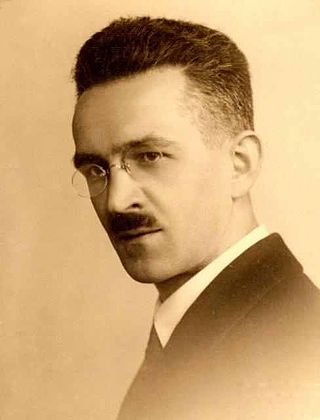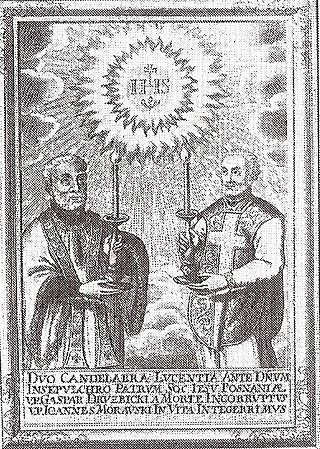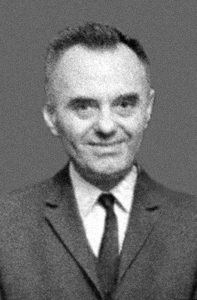
The Jagiellonian University is a public research university in Kraków, Poland. Founded in 1364 by King Casimir III the Great, it is the oldest university in Poland and the 13th oldest university in continuous operation in the world. It is regarded as Poland's most prestigious academic institution. The university has been viewed as a vanguard of Polish culture as well as a significant contributor to the intellectual heritage of Europe.

Nicolaus Copernicus was a Renaissance polymath, active as a mathematician, astronomer, and Catholic canon, who formulated a model of the universe that placed the Sun rather than Earth at its center. In all likelihood, Copernicus developed his model independently of Aristarchus of Samos, an ancient Greek astronomer who had formulated such a model some eighteen centuries earlier.

Olkusz is a town in southern Poland with 36,607 inhabitants (2014). Situated in the Lesser Poland Voivodeship, previously in Katowice Voivodeship (1975–1998), it is the capital of Olkusz County. Olkusz is known for its abundance of silver, which is mined and extracted in the vicinity.

Sonderaktion Krakau was a German operation against professors and academics of the Jagiellonian University and other universities in German-occupied Kraków, Poland, at the beginning of World War II. It was carried out as part of the much broader action plan, the Intelligenzaktion, to eradicate the Polish intellectual elite, especially in those centers that were intended by the Germans to become culturally German.
The Kraków School of Mathematics and Astrology was an influential mid-to-late-15th-century group of mathematicians and astrologers at the University of Kraków.

The Nicolaus Copernicus Monument in Warsaw is one of the Polish capital's notable landmarks. It stands before the Staszic Palace, the seat of the Polish Academy of Sciences on Krakowskie Przedmieście. Designed by Bertel Thorvaldsen in 1822, it was completed in 1830. Thorvaldsen's original plaster model from 1822 and a smaller study from 1821 are both held by the Thorvaldsen Museum in Copenhagen.
Copernicus is a 1973 Polish historical film directed by Ewa Petelska and Czesław Petelski. The film was entered into the 8th Moscow International Film Festival where it won the Silver Prize. It was also selected as the Polish entry for the Best Foreign Language Film at the 46th Academy Awards, but was not accepted as a nominee.
The Institute for the History of Science was established in 1954 as an institution of the Polish Academy of Sciences in Poland.

Aleksander Ludwik Birkenmajer was a Polish historian of exact sciences and philosophy, bibliologist, professor of the Jagiellonian University in Kraków and of the Warsaw University.

Astronomer Copernicus, or Conversations with God is a painting by the Polish artist Jan Matejko completed in 1873, in the collection of the Jagiellonian University, Kraków. It depicts Nicolaus Copernicus observing the heavens from a balcony in a tower with the cathedral in Frombork in the background. The canvas was purchased from a private owner by public subscription in Poland and hangs in the aula of the Collegium Novum of the university. Matejko produced the painting as part of a series of paintings intended to capture and represent key moments in the history of Poland to inspire the public.
Marcin Bylica, also known as Martin Bylica and Marcin z Olkusza, was a Polish astrologer, astronomer, and physician at the court of Matthias Corvinus, King of Hungary.

Jan Morawski was a Jesuit, theological writer.
Petrus Gaszowiec, was a Polish astrologer, doctor and professor at the Kraków Academy.

Roman Stanisław Ingarden was a Polish physicist, specialised mainly in optics and statistical mechanics, son of the Polish philosopher Roman Witold Ingarden.

Rectors of the Jagiellonian University – List of rectors of the Jagiellonian University, known also as the Cracow Academy, University of Cracow, and Szkoła Główna Koronna. The list begins in 1400 at the restoration of the university under Jadwiga of Poland and Władysław II Jagiełło.
Jerzy Sikorski is a Polish historian, Copernicologist, medievalist, museologist, author, publisher, journalist, and encyclopedist, who writes and publishes primarily in Polish. He is a resident of Olsztyn, Poland.
Jan Muscenius, was a Polish astronomer, theologian, and the rector of Kraków Academy.
Franciszka "Niusia" Szymakowska-Birkenmajer was a Polish geologist. He worked at the Polish Geological Institute in Warsaw, and an important figure in the development of Carpathian geology. Her main research interests were the stratigraphy and tectonics of the Carpathians. Franciszka Szymakowska was best known for her detailed geological drawings that are still used today. Most geological maps at her time were drawn by with pencil and colours, and Szymakowska was able to capture the most complex geological features in accurate and detailed images.










